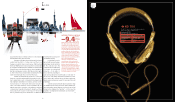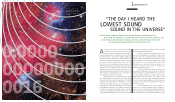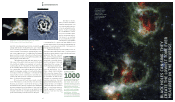Sennheiser 2011 Annual Report Download - page 12
Download and view the complete annual report
Please find page 12 of the 2011 Sennheiser annual report below. You can navigate through the pages in the report by either clicking on the pages listed below, or by using the keyword search tool below to find specific information within the annual report.
10 Hz
22
10 Hz
WALE
UNDERWATER HITS
SOME WHALE SPECIES HAVE NEVER
BEEN SEEN ALIVE BY HUMANS.
ONLY THEIR CALLS REACH US.
Centuries ago and late at night,
as rum-sodden sailors lay in an
exhausted stupor in the ship’s
hold, listening to the planks creaking
and the wind whistling through them,
the strange sounds coming from the
depths of the sea must have been hor-
rifying. For these superstitious sea
dogs, there was only one logical expla-
nation behind the melancholy groans
that seemed to reverberate as if from
some supreme soundboard: it must be
a chorus of seamen, sobbing from
their watery graves. Riddled with fear,
some nights the sounds were almost
too much to bear. Worse yet was the
knocking. The spirits had more on their minds than singing
their hair-raising song of woe. They wanted in.
Sporting oval, wire-framed glasses and an ordinary,
no-nonsense haircut, English marine biologist Oliver Bois-
seau, 36, seems – well – so normal. That is until he begins
to revel in telling horror stories of the deep seas. His haunt-
ing tales, however, do serve a purpose. Recounting such old
sea lore is an excellent illustration of man’s ignorance of
these, his most favorite of creatures – the ancient masters
of the sea. It wasn’t until the 1930s, when dolphins first
went on show in aquariums, that man began to observe
marine mammals; it took another 10 or 20 years before sci-
ence slowly began to get itself into the act.
But it wasn’t until a good 40 years ago that man
began to analyze the whale’s poignant sounds. And as un-
derstanding grew, so too the realization that the ghostly
seaman’s lament were actually poetic songs used by some
species of whales to woo their female mates. The songs
broadcast relevant and detailed information as to their
size, strength and matrimonial intentions. And the knock-
ing sounds? A special sonar toothed whales use to locate
their prey.
Though research in this field is still in its infancy,
there is another reason why so little is known about
whales. Most of them tend to keep out of sight, preferring
to romp about in the unfathomable
expanses of the ocean. Relatively
easy to spot are the large baleen
whales. As Captain Ahab in Moby-Dick
would say, “There she blows! The
white whale.” And indeed, a huge
fountain of water shoots into the air
as they exhale; a sight Boisseau can
see for miles.
It’s a completely different
story for the most mysterious of
these large marine mammals: the
beaked whale. Though they make up
almost 25 percent of the approxi-
mately 80 whale species, only four
species have been studied in any de-
tail. For some beaked whale species, the only proof of their
existence is their skeletal remains. But how many are there?
A question still in search of an answer, it will take more lis-
tening in on the deep to fit the different pieces of the puz-
zle together.
At 18, when Boisseau finished school, he took a year
off to do voluntary service. With his brother already work-
ing with wild animals in Africa, Boisseau was “looking for
something completely different to do.” And so began his
love affair with marine mammals. Over the course of the
year, Boisseau worked on whale-watching boats off the
Azores and assisted American doctoral candidates with
their research. The subject was always dolphins and whales.
But it wasn’t until fourteen years
later, in 2008, that Boisseau finally
spotted a live beaked whale. Surely
a baffling fascination given that the
object of his obsession remains so
elusive.
Today, a Ph.D. himself, Bois-
seau conducts his own months-long expeditions, now con-
sidered the most important in the field of whale research.
At the end of March 2012 and sponsored by the environ-
mental-protection-organization International Fund for Ani-
mal Welfare, Boisseau set sail to observe the Atlantic’s blue,
1. The 36-year-old marine biol-
ogist Oliver Boisseau on the deck
of the research ship “Song of
the Whale.”2. Screams, piping,
whimpers and grunts: hump-
back whales sing their songs in
verses of diverse sounds.
























